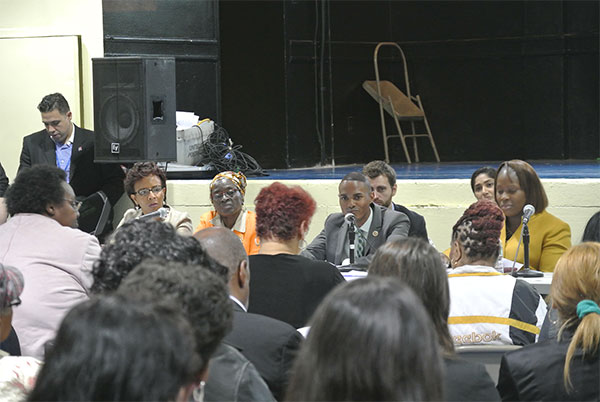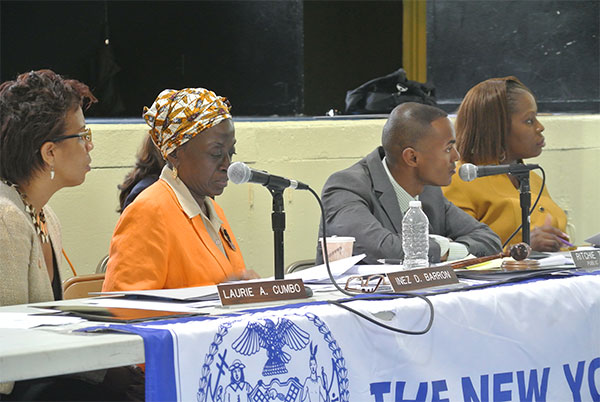CM Torres led a public housing committee hearing in Brooklyn (all photos: Katrina Shakarian)
"Fix the locks! Put up security cameras!" called out Olivia Taylor from a corner of the Breukelen Houses' Community Center in southeast Brooklyn. Taylor interrupted the crowd's silent focus on the City Council's latest public housing hearing, until order was restored with several strikes of the committee chair's gavel.
Taylor was one of several public housing residents, lawmakers, and advocates who gathered at the public housing complex on Tuesday, September 16, for a hearing to discuss the roll out and progress of Mayor Bill de Blasio's $210.5 million plan to reduce violent crime in public housing.
Between 2009 and 2014, overall crime across the New York City Housing Authority's (NYCHA) 334 developments rose 30%, according to NYPD Housing Bureau Chief Carlos Gomez, a key speaker at the hearing. The spike in crime is explained, in part, by rising incidences of domestic violence and gang activity.
The Mayor's plan is coordinated among ten different agencies and targets 15 public housing developments, where 17 percent of NYCHA's violent crime has been concentrated for the past three years. Since the program's launch on July 8th, the NYPD's Housing Bureau has reported an overall drop in crime across NYCHA, though certain developments and categories of crime have seen increases.
Tuesday's hearing was the second ever to take place at a public housing complex, both coming this year under the leadership of new City Council Speaker Melissa Mark-Viverito and new Public Housing Committee Chair Ritchie Torres. The Breukelen Center was chosen as the site due to its proximity to the Boulevard Houses, the development where 6-year old Prince Joshua (PJ) Avitto and 7-year old Mikayla Capers were brutally stabbed in June. A recently paroled, paranoid-schizophrenic man wandered into their building through doors with broken locks and in the absence of security cameras. He got into an elevator with both children, who were en route to get ice pops, where he stabbed them.
"Kids in NYCHA developments deserve to grow up in a safe environment just like kids in any other part of the city. We are here today to remember PJ and to work together to ensure the safety of all NYCHA residents," said Torres in his opening statement, before convening the meeting with a moment of silence for PJ Avitto, who died from the attack.
Crime data, as outlined in a city council briefing paper, indicates that between January 1 and August 24 2014 overall crime decreased by 4% across all NYCHA developments and by 3% at the 15 targeted ones, compared to the same period in 2013.
At the hearing, Chief Gomez presented attendees with post-launch crime statistics, which he described as "a significant step in the right direction." Between July 1st, when the NYPD received funding to implement their portion of the new initiative, and September 14th of this year, overall crime in public housing decreased 14.4 percent. In the 15 targeted developments overall crime dropped by 7.4 percent, said Gomez.
Yet, despite the overall decrease in crime, a deeper dive into the statistics reveals that the gains are not all-encompassing. According to Gomez, there were 54 shootings across the bureau versus 52 in the same July to September period last year. Even with additional resources, crime spiked in six of the 15 the developments being targeted. The Bushwick Houses, for example, saw ten felony assaults between July 1st and September 14, compared with just two during the same time last year.
Torres was joined at the hearing by Council Members Cumbo, Barron, and Gibson, among others
The mayor's initiative to combat these trends is four fold. It includes security related infrastructural improvements such as the installment of light towers and security cameras; increased police presence; the expansion of resident programming such as the Summer Youth Employment Program, domestic violence support and mentoring services; and community outreach and engagement such as collecting resident feedback through surveys.
"The success of the plan hinges on that last part," asserted City Council Speaker Melissa Mark-Viverito in her statement at Tuesday's hearing. Mark-Viverito and others are looking at the initiative's success in collaborating with community leaders, organizations, and residents that do the heavy lifting on the ground to make their neighborhoods better places on a daily basis.
"These leaders and residents must be meaningfully engaged and consulted every step of the way," Mark-Viverito said, eliciting applause from the crowd. "They know what the community needs, because they are the community."
Elizabeth Glazer, Director of the Mayor's Office of Criminal Justice, touted some initial results in each of these categories, which taken with Gomez's statistics, suggest that the mayor's initiative has made a dent. She ran down a list of accomplishments:
- 184 light towers, meant to increase visibility and deter illicit activity, installed at different developments since July launch
- the plan to install roughly 2,000 security cameras in 43 developments, has completed installation in 19
- Almost 20,000 feet of shedding or scaffolding not associated with active construction has been removed from developments since May
- 150 police officers deployed on the ground in targeted developments each week
- extended summer hours in NYCHA's 105 community centers for the first time in 30 years
- 1000 additional youth from the 15 targeted developments were employed through the Summer Youth Employment Program in 2014
Nonetheless, Mark-Viverito captured the sentiment of many at the hearing when she asserted, "the success of this plan should not be just measured by crime statistics or numbers of officers and cameras, but also by whether residents actually feel safer in their homes." Her statement underscored the significance of the location and format of Tuesday's hearing.
Marie Boone, resident leader at the Tilden Houses in Brooklyn, testified at Tuesday's hearing. "When I heard about the development list of 15, I could not understand, why was Tilden omitted," she said to the panel of council members. Tilden Houses is adjacent to the Brownsville and Van Dyke Houses, both of which are targeted by the mayor's initiative.
"For the last two years, Tilden has been plagued with street gangs," Boone explained. "Street gangs mean children between the ages of 9 to 21, using bats, sticks, wrapping the hand chain...the kids were constantly fighting each other, without no real reason." At the end of August, the fighting culminated in the death of a young man, an 18 year old from Boone's community, who planned to attend college this fall, she said.
Tilden's testimony was a sobering reminder of what's at stake behind the numbers, and highlights the need for what many have already called for: that the mayor's initiative is scaled beyond the current 15 developments.
***
by Katrina Shakarian, Gotham Gazette
@KatShakarian






